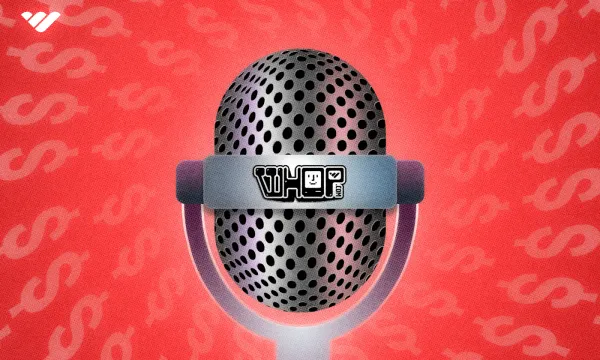Everyone from celebrities to Youtubers, to entrepreneurs and creatives is starting a podcast. With almost 5 million podcasts on Spotify, more and more people are choosing to listen to podcasts over any other medium.
Does that mean you should jump on the bandwagon and start a podcast? Before you buy a Blue Yeti microphone, it's a good idea to take the time to learn how to make money from a podcast.
I don't know about you, but I'm not going to waste time with a side hustle that doesn't have the potential to generate income, and you shouldn't either. So, if you want to start a podcast and make money, let's dive deep into the steps you need to make this work.
How Much Money Can You Make Podcasting?
Want to know the most profitable podcast?
It's The Joe Rogan Experience. With over 190 million monthly downloads, Joe averages $100,000 per episode.
And how much does the New Heights podcast make per episode? With the popularity of the Super Bowl and Travis Kelce dating Taylor Swift, it’s no wonder that the New Heights podcast – the second most popular show – could be worth $100 million.
But having a large audience doesn't mean you'll make money. In fact, with 4.15 million podcasts, most aren't monetized.
Content creators either need to learn how to make money with a podcast or cultivate an engaged audience to monetize their content.
If that's you, read on to learn how to monetize your podcasts.
How to Make Money With a Podcast
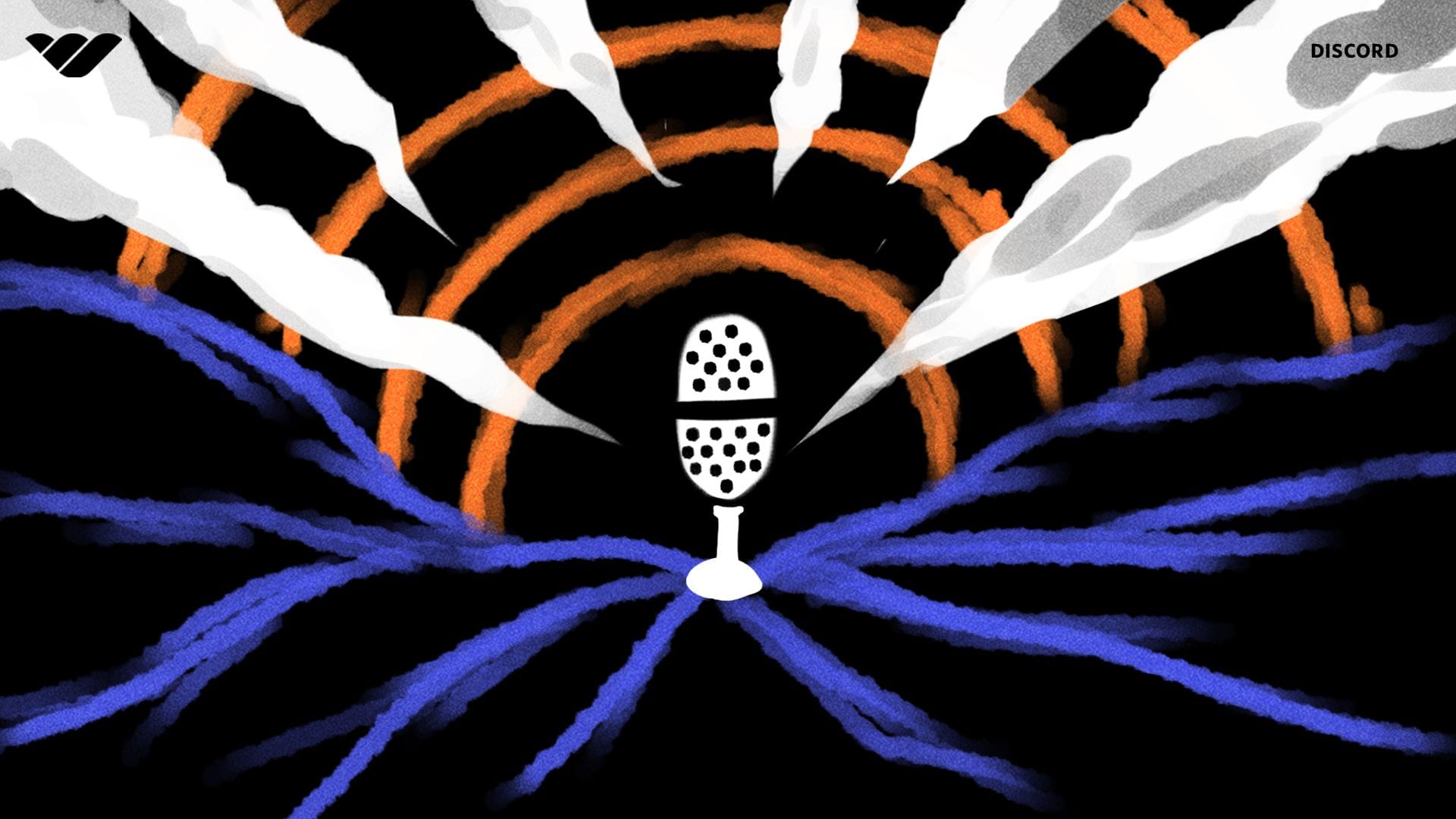
While you can't expect to make money right away with your podcast, if you have a solid show idea, there are steps you can take to ensure your podcast will be successful. Make sure that you hit all of these points before you even think about trying to make money with your podcast.
Define Your Niche
Figuring out your profitable podcast begins with picking the right subject matter, who your audience will be, and deciding the unique value that helps your podcast stand out in a crowded market.
Choosing a subject that has the potential to attract listeners involves conducting market research. Look into existing podcasts in your area of interest. Are they thriving? What kind of engagement do they receive?
For example, if you enjoy reading and talking about fictional universes like the ones in Games of Thrones, Harry Potter, and other pop culture media, check out what people say about the podcast, House of R.

You can also check out social media groups and discussions about your topic. The more buzz and activity you see, the more likely your subject matter is popular and has a built-in audience.
For example, if you want to create a podcast about AI and its integration into education, you can check to see if there are Facebook groups and how large those groups are. This will give you an idea about how popular your subject is.

Go ahead and join these groups to get to know the audience. What questions do they have, and what do they want to know? From there, you can develop an avatar of your ideal listener.
Remember to carve out a unique angle on your subject. This will help your audience remember what your podcast is about and help make it popular.
It can be as simple as the format of your podcast. You could blend storytelling with expert interviews or incorporate live listener Q&A sessions. The key is to think creatively and find an approach that aligns with your subject matter, resonates with your audience, and keeps them coming back for more.
Be Consistent
The biggest downfall of a successful podcast is a lack of consistency. According to Jack Butcher, creative director for Fortune 100 advertising in NYC, about 90% of podcasters don't publish more than three episodes.
If you don’t want this to happen to you, create a recording and publishing schedule and stick to it. You can have a daily, weekly, monthly, or seasonal podcasting schedule.
For example, Serial is a groundbreaking podcast that uses investigative journalism to uncover true crime cases. The first season, which had only 13 episodes, was downloaded 68 million times.
The journalist, Sarah Koenig, focussed the first season on one case, helping to quickly build up a listener base and hold her accountable to producing episodes consistently.
Whether you plan to have 13 episodes or 35, work on mapping out each episode and batching your filming. This way, you'll have the entire season done before you launch your podcast.
Include the following when mapping out each episode:
- Create an outline: define your objective and include key points and segments
- Block time for batch recording: schedule regular recording sessions (e.g., every Thursday for a weekly podcast)
- Set deadlines for pre-production: If you need to do research or interviews, set deadlines to complete tasks before the recording day.
- Edit each podcast and account for buffer time: allocate time for editing your recordings and make a day of it or block a time to complete this task. Also, plan a buffer period between recording and release to account for any last-minute adjustments or technical issues.
Create an Engaged Community

Many podcasters focus too much on growing their audience after launching their podcasts. This is probably because they’re wondering how many listeners they need to make money with a podcast.
It’s not how many listeners you have; it’s how engaged they are. A more engaged audience generates more income.
To increase engagement, encourage reviews and ratings, ask listeners for feedback, and create an online community around your podcast.
A simple yet effective way to grow a podcast audience and improve its visibility is by encouraging your listeners to leave ratings and reviews. Apple Podcasts uses these ratings as part of their algorithm to determine which podcasts to promote.
This also encourages engagement when listeners see the reviews and ratings of your podcast. Don't hesitate to ask for one at the end of your episodes. A gentle reminder can go a long way.
Here’s a script to try,
“Quick favor – if you're loving the podcast, could you leave a rating and review on Apple Podcasts? It really helps us grow and reach more listeners. Plus, I'd love to hear your feedback. Thanks for being awesome, (podcast name) fans!”
This invites a review and any feedback that can help make your podcast more successful. A few common feedback suggestions include episode structure changes, background music being too loud or unnecessary, not enough content depth, and slow pacing.
For example, the podcast This is Actually Happening tells harrowing accounts of stories from people. Each episode is narrated by them, and all you hear is their voice. However, the podcast started adding background music, and many listeners left feedback, mentioning that it was unnecessary or overpowering.
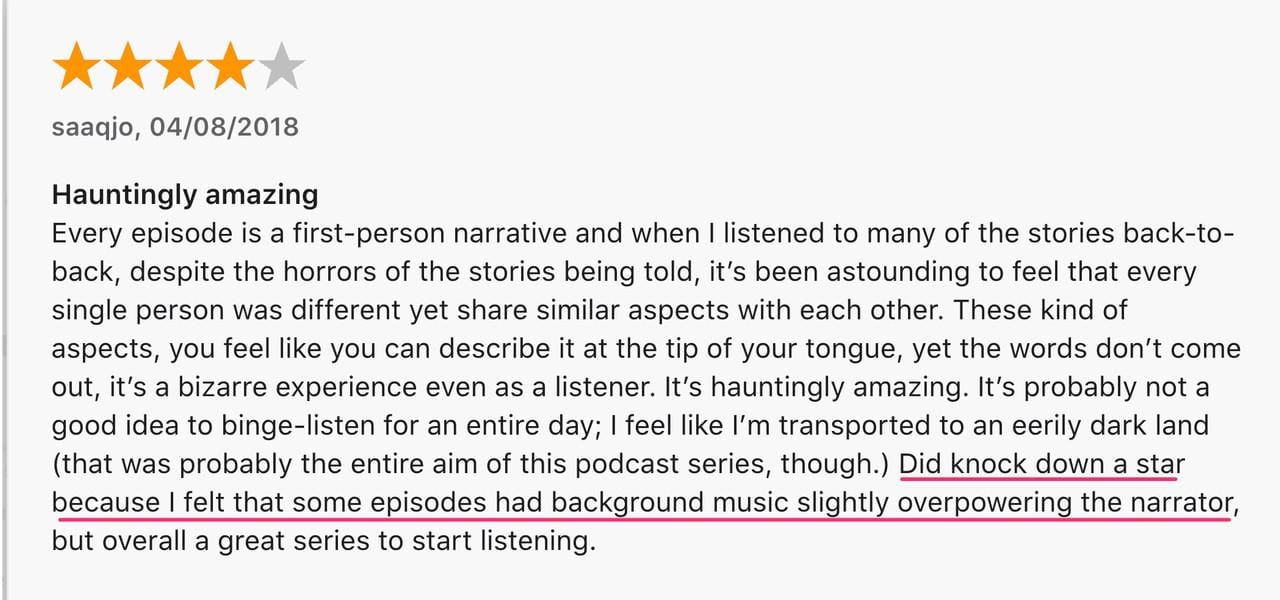
The podcast's creators listened to their audience and stopped the background music.
And why stop at a podcast to grow and engage an audience? You can start an online community alongside your podcast to create a deeper connection with your listeners. This type of community offers a space for people to interact, share feedback, and feel more connected to your content. Active communities can also attract new listeners and offer additional monetization opportunities (which we will discuss next).
7 Ways to Make Money with a Podcast
With a solid strategy for your podcast, you can now look forward to monetizing this new side hustle. Here are seven easy ways to make money podcasting.
1. Place Ads
The simplest (and most passive) way to monetize your podcast is to place ads. Don’t worry – your listeners are used to ads by now, and according to SiriusXM, 90% of listeners will even act on those ads.
But how do you place ads in your podcast? Just as a blogger can sign up to an ads network for ad placement, a podcaster can also sign up to a podcast ad network to place ads in their episode.
These networks bring brands together with podcasts, allowing the creator to start generating income every time they publish an episode. Companies like Adopter Media, Veritone One, and Audioboom will offer:
- Pre-roll and mid-roll ads – ads placed before or during the podcast episode
- Post-roll ads – are placed at the end of the episode
- Host-read ads – these ads are baked into the show since the host reads them as part of the podcast episode
Depending on the length of each episode and how active your listeners are, you can place anywhere from 2-8 ads per episode. But always play around with the frequency of ads to find the right balance. Too few ads might limit revenue potential, while too many could annoy listeners.
Ad platforms will also give you audience insights like demographic information, listening habits, and engagement metrics. Use this data to target your ads more effectively. When you understand the data, you can allow advertisers to reach specific segments, increasing the ad slot value.
2. Add a Sponsorship
Sponsors are similar to ads. Sponsors are a company or organization providing financial compensation or products in exchange for airtime on your podcast. You'll give their brand a shoutout, talk about their products, or even dedicate a segment to them. It's a cool way for you to keep your podcast running and for sponsors to connect with your listeners.
While you can also use a network to find sponsors, many podcasters aren’t ashamed to reach out to sponsors on social media.
The Minerals & Royalties Podcast creator Tim Pawul is posting on LinkedIn about a new sponsorship opening.
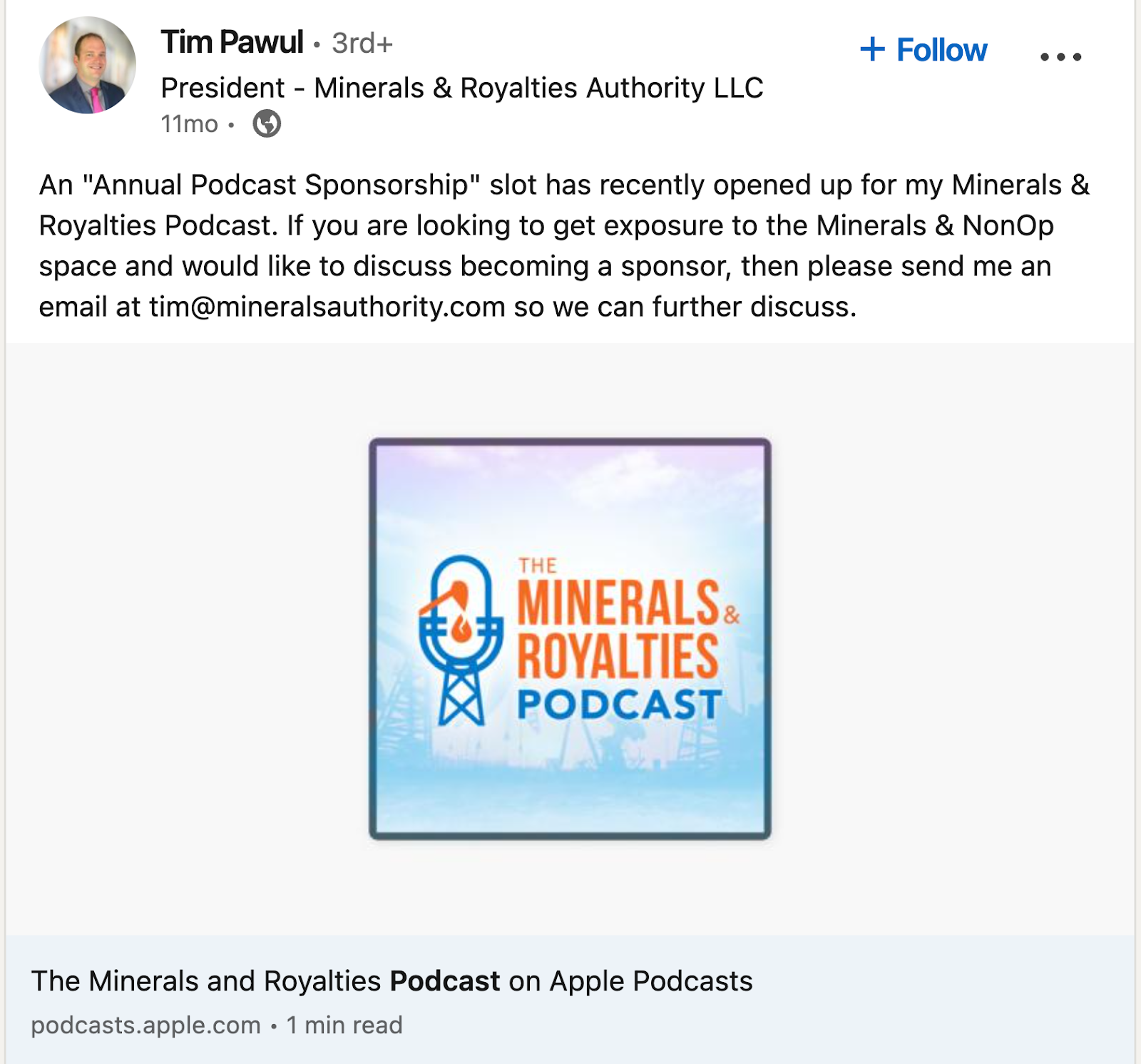
Asking for sponsors this way can also connect you with affiliate marketing brands. You team up with brands that align with your podcast's niche and audience interests. Then, you mention their products or services during your episodes, and you earn a commission for every listener who makes a purchase through your unique affiliate link or uses your special promo code.
It's a win-win: your listeners discover valuable products, and you get a slice of the revenue. Just make sure the promotions feel natural and relevant so your audience has a smooth experience.
3. Sell Merch
If your podcast takes off and you’re dialed in with your listeners, you’ll soon learn they may want some merch to feel part of your show and more emotionally connected to your brand.
For example, actors Tig Natorio, Mae Martin, and Fortune Feimster created the Handsome Podcast, a comedy and storytelling show. Many of their active listeners blasted the Handsome podcast Facebook page, wanting merch from them. They received the feedback and eventually created hats, underwear, and sweatshirts for their audience.
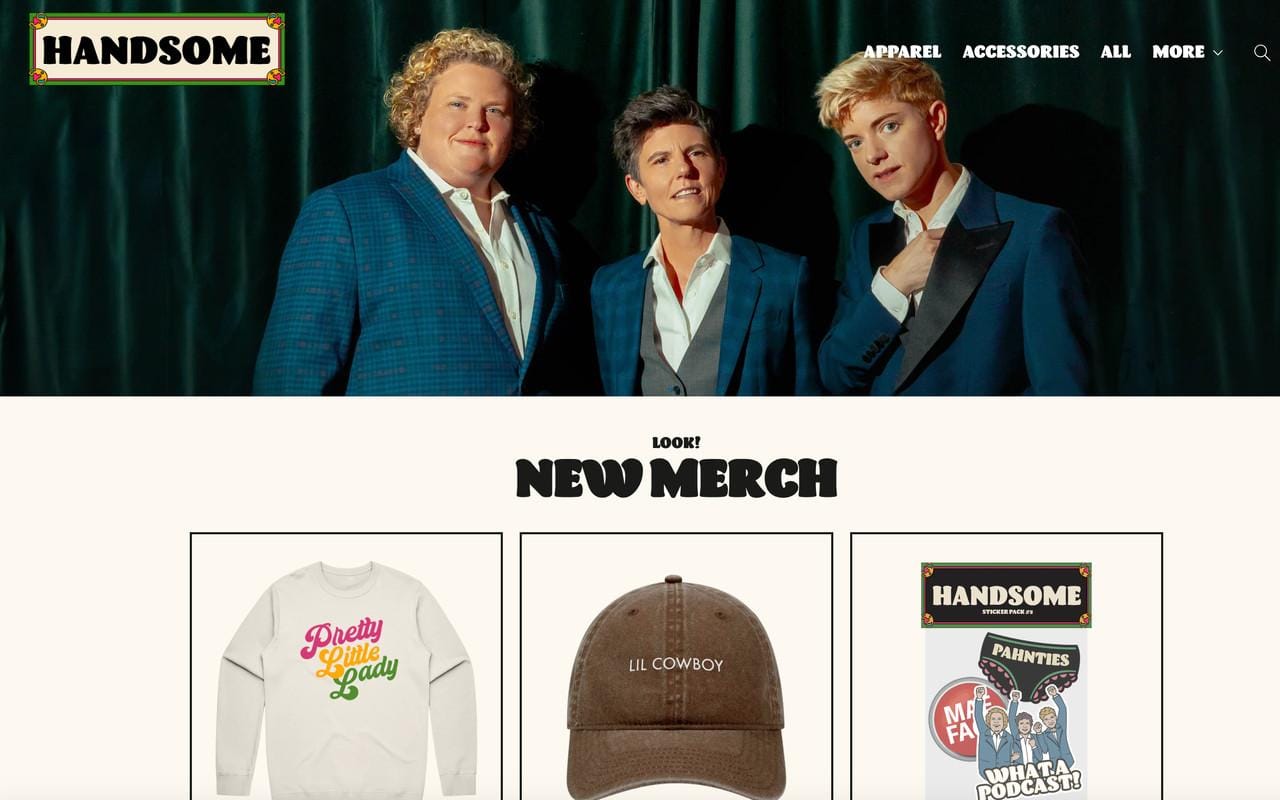
To start selling merch, you only need a print-on-demand platform like Printify to do all the heavy lifting. A POD platform will print your designs onto the merchandise, packaging the items, and shipping them directly to your customers. Most POD platforms will have various products on which to place your design. Examples include socks, bags, yoga mats, water bottles, stickers, and phone cases.
For many podcasts that sell merchandise, the design is typically a familiar phrase the host says or the podcast logo. Once you have your design, upload it to the POD platform. From there, you’ll need to connect it to an eCommerce store. You can use Etsy, Amazon, Shopify, or a plugin like WooCommerce for your website.
4. Offer a Paid Community
You know that online community you started alongside your podcast to build engagement? Why not turn that into a paid membership?
A paid membership is a smart way for content creators, entrepreneurs, and influencers to share exclusive digital content or products with their audience for a monthly membership fee. With a membership, you can offer fans bonus episodes, unedited interviews, exclusive merch, or early access to live show tickets.
Take a look at the Not Another D&D Podcast. They have 40,000 members and three pricing tiers ranging from $2/month up to $10/month, making their podcast highly successful.
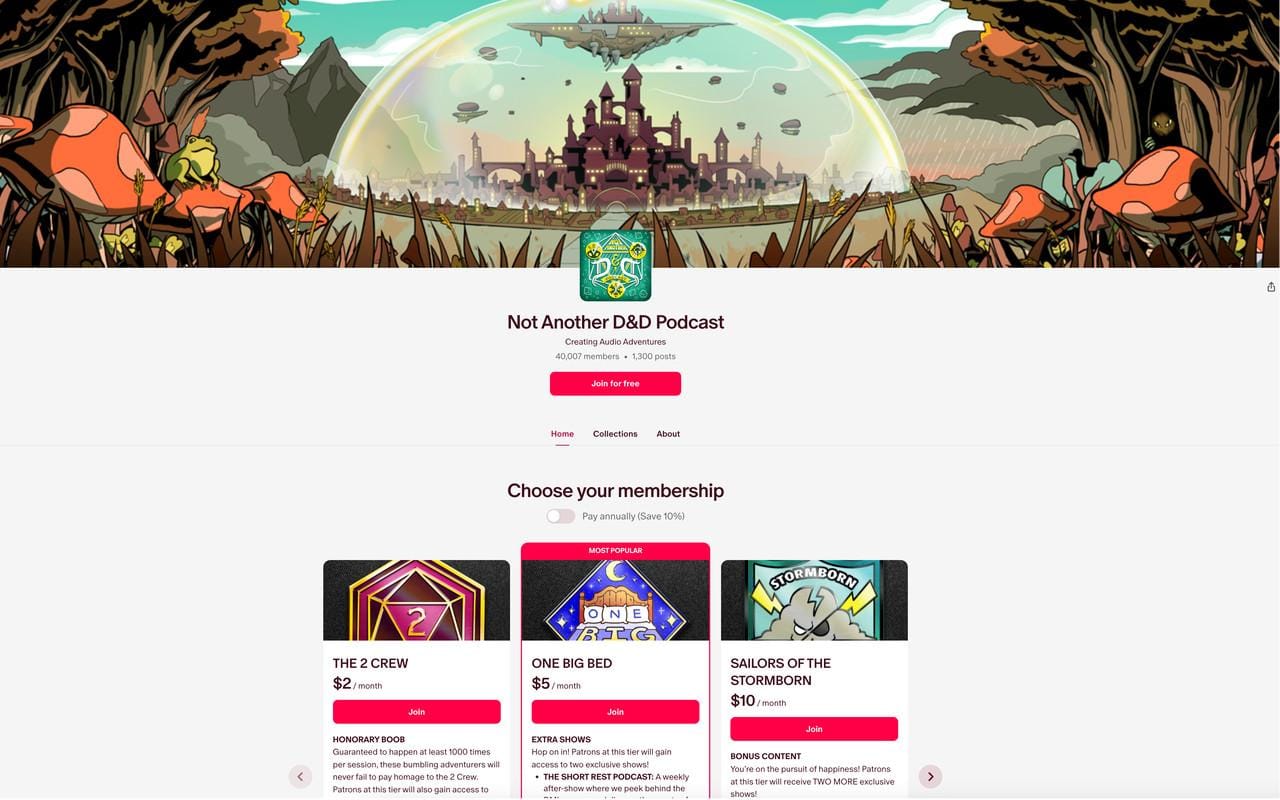
To get started with a membership, determine what exclusive content or products you’ll offer your fans, such as behind-the-scenes content, exclusive interviews, helpful guides, or early access.
Use a platform like Patreon, Discord, or Whop to host your membership site. Next, figure out the branding of your online store and set up the membership levels or tiers if you plan to offer different access or content for different prices. Once that’s all sorted out, you can start sharing your podcast membership and encouraging people to join.
5. Create a Paid Newsletter
Another way to make money with a podcast is with a paid newsletter. Email marketing has a higher ROI – $36 for every $1 spent – than any other method like social media.
Your paid newsletter can round up supplemental information related to each podcast episode you publish. For example, if your podcast is about AI and the education system, a paid newsletter idea might share AI writing prompts for teachers specific to each grade level.
Ben Thomas is behind the Stratechery – a podcast and paid newsletter sharing tech and media news and how each shapes people today. He shares weekly articles for free, but if you want more, his paid subscribers get exclusive access to three additional Daily Updates every week.
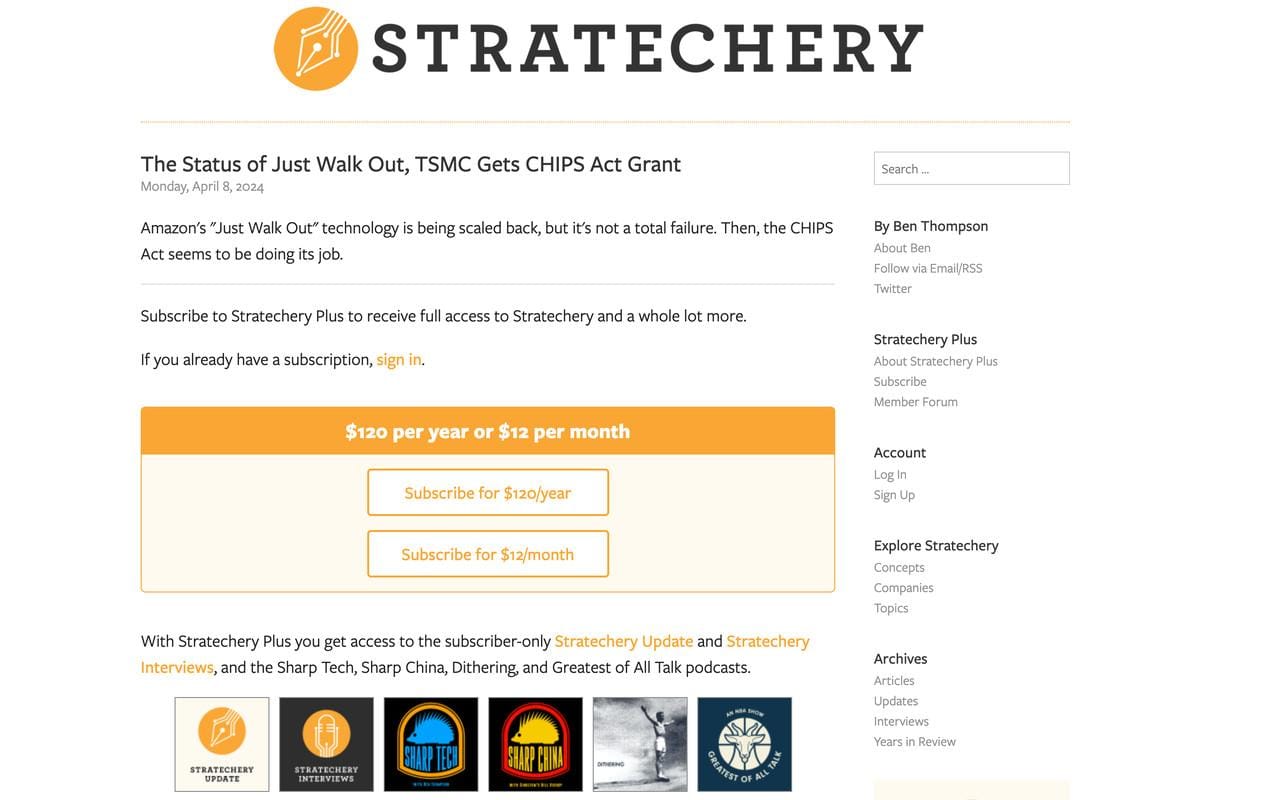
To start a paid newsletter, create a content schedule for each email you want to create. It’s best to base it on each podcast episode, so listeners become more invested in your brand. Decide on your pricing model for a monthly and yearly subscription. Then, choose a reputable platform like Substack, Ghost, or Whop to host your newsletter.
6. Publish an eBook
If you ever wonder how podcasts make money, publishing an eBook is probably it.
Many celebrities and influencers start podcasts to sell an eBook to grow their brand and message.
A perfect example is Amy Porterfield.
She’s a popular online marketing expert, author, and educator known for helping entrepreneurs and small business owners grow their businesses through digital marketing. She also has a long-standing podcast, Online Marketing Made Easy, which focuses on marketing strategies, expert interviews, and practical tips to help listeners build successful online businesses.
With her growing audience, she recently published a book, Two Weeks Notice, and it instantly became a New York Bestseller, all thanks to her podcast listeners and fans.
She even created a podcast episode detailing her marketing strategy to launch her new book, introducing listeners to her upcoming book launch.
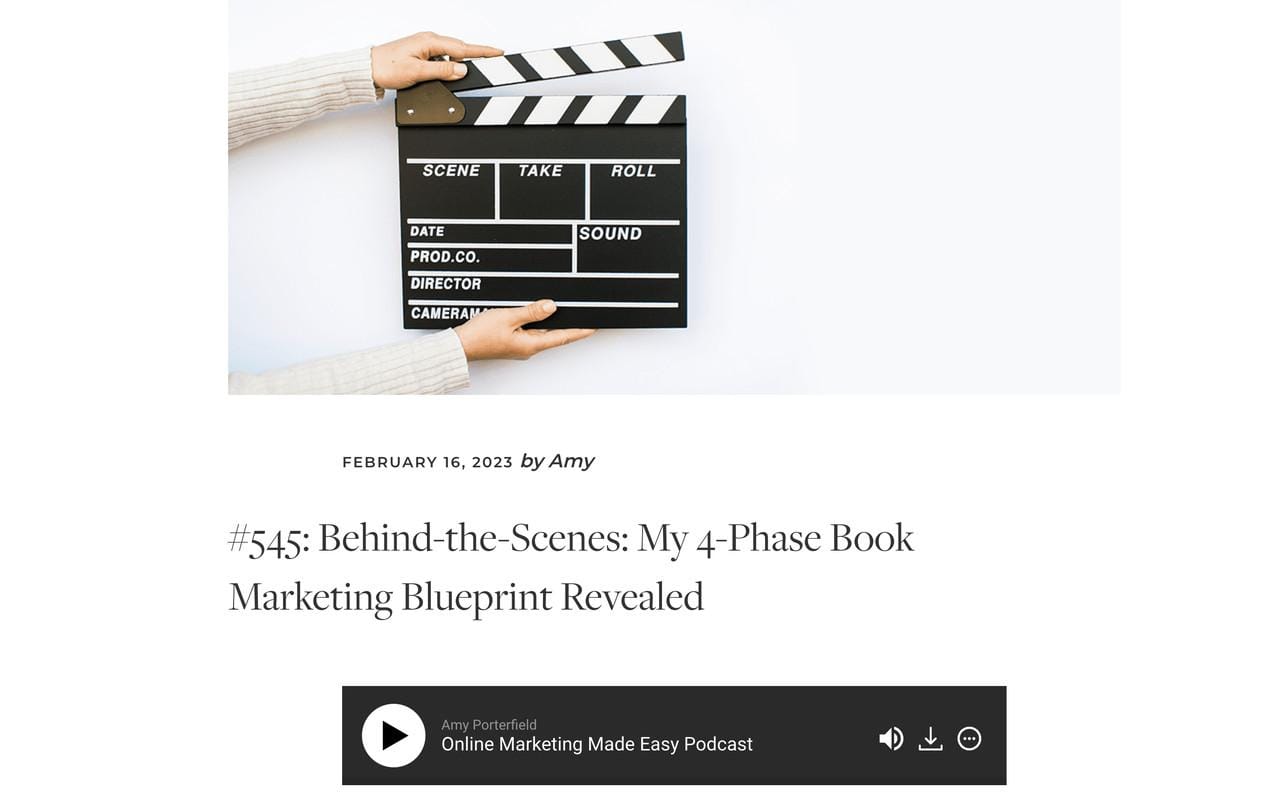
If you have a personal brand, you can create an eBook from your knowledge. Think of a simple plan, a small strategy, or a roadmap to build your eBook.
Once you compile the pages and get a designer to create cover art, you can publish and distribute your book on a shopping platform like Amazon, Gumroad or Whop. With Whop, you can easily sell your eBook, host your podcast, membership, and more.
7. Create and Sell Courses
A great thing about a podcast is the influx of new fans. Capture those fans by creating a personal brand they can’t live without. You can easily do this by creating and selling courses. Influencers, entrepreneurs, and business owners use courses as a way to elevate their brand, show authority in their subject matter, and, of course, generate diversified income.
This method is more challenging than creating an eBook or paid newsletter. Courses often include video training and modules filled with lessons, resource guides, templates, and even swipe files.
But, when your audience craves a course, you have to listen. Entrepreneur and marketer Tony Hill has recently been sharing Pinterest tips with his newsletter subscribers – and they are eating it up. They are asking Tony for more.
“I've been getting a lot of people reaching out asking if I do Pinterest consulting. I've turned everyone away because I don't have time to do 1:1 consulting.”
A few weeks later, though, he decided to find a way to give his audience what they wanted: exclusive behind-the-scenes Pinterest marketing tips. He started an online community and is going to create a course.
“So yeah, due to popular demand, I'll be creating a course showing you my unique Pinterest strategy.”
A profitable course idea is unique, replicable, and simple to execute.
Once you figure out that million-dollar idea, use a course platform like Teachable, Thinkific, or Whop to host and sell your course.
For example, Laude has a course on Whop that helps people have a standout interview during the recruiting process.
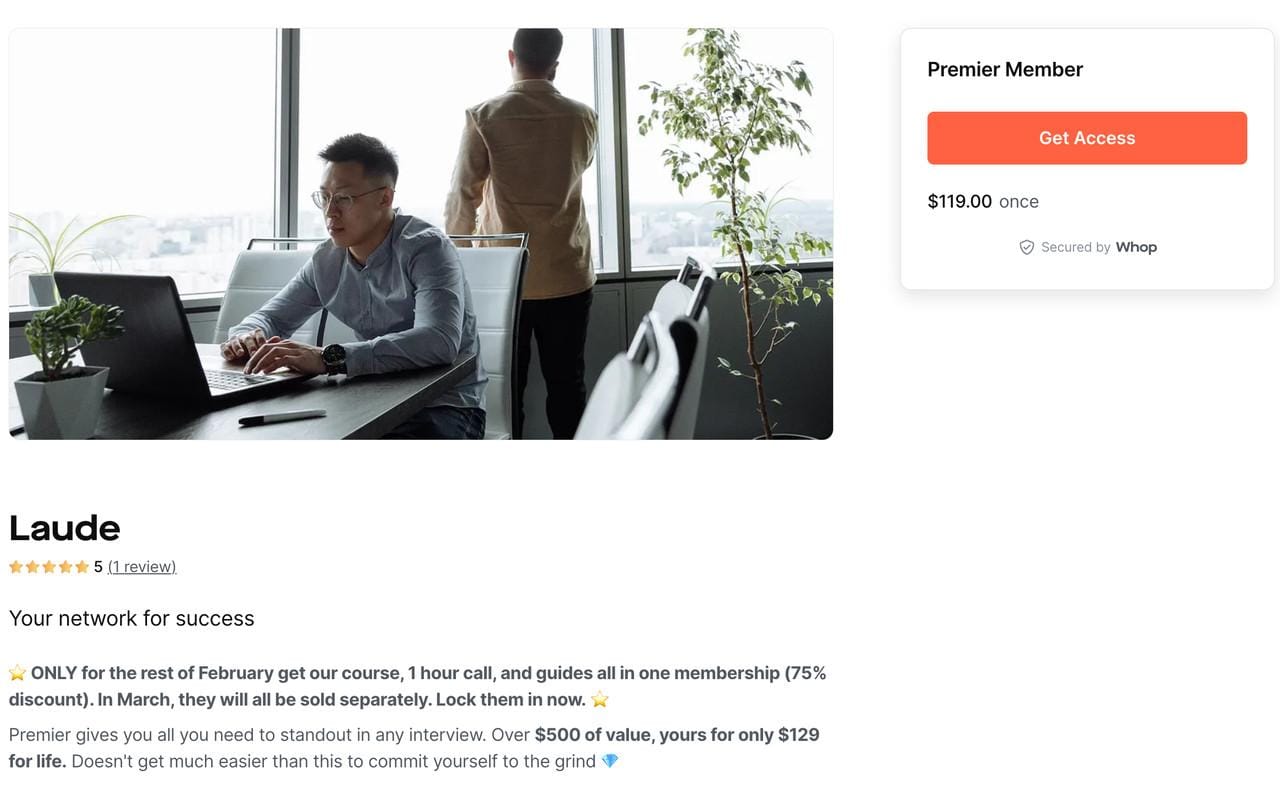
Monetizing Your Podcast With Whop
As you can see, there are many ways that you can make money with a podcast, and with Whop, you can create multiple income streams in one place. When you create your Whop, you can sell:
- Memberships
- Courses
- eBooks
- Software
- Communities
- Digital products
All from one platform and for one fee - just a 3% transaction fee. No monthly membership fees or signup fees needed - Whop only takes a small percentage of your sales.
To set up a Whop for your podcast, sign up for a free account and add apps to your product. Then, set a price for access to your Whop.
Once they pay for Whop, listeners can access your podcast, access premium version of your podcast, view courses, and engage with a slew of other Whop apps that you may like to integrate like a forum, members chat, Discord server access, giveaways, and more!
It only take a few minutes to get started and setup your Whop - so start making money from your podcast today!
